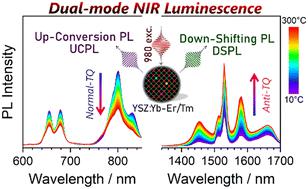当前位置:
X-MOL 学术
›
Dalton Trans.
›
论文详情
Our official English website, www.x-mol.net, welcomes your
feedback! (Note: you will need to create a separate account there.)
Er3+/Tm3+ co-doped Zr0.85Y0.15O1.925:Yb3+ phosphors: dual-mode ratiometric thermometry based on near infrared up-conversion/down-shifting photoluminescence
Dalton Transactions ( IF 3.5 ) Pub Date : 2024-07-25 , DOI: 10.1039/d4dt01972e Takuya Hasegawa 1 , Yuki Takahashi 1 , Tomoyo Goto 2, 3 , Yasushi Sato 4 , Ayahisa Okawa 1 , Shu Yin 1, 5
Dalton Transactions ( IF 3.5 ) Pub Date : 2024-07-25 , DOI: 10.1039/d4dt01972e Takuya Hasegawa 1 , Yuki Takahashi 1 , Tomoyo Goto 2, 3 , Yasushi Sato 4 , Ayahisa Okawa 1 , Shu Yin 1, 5
Affiliation

|
Ratiometric thermometry is among the emerging applications in phosphor materials. Particularly, the technique of ultrafine-space thermometry has garnered significant attention in bio-imaging. Near-infrared (NIR) light, with its high tissue permeability, serves not only as an excitation source for up-conversion photoluminescence (UCPL) but also induces down-shifting photoluminescence (DSPL) at longer wavelengths. These luminescence mechanisms offer promising avenues for bio-available thermometry. In this study, we focused on highly bio-adaptable yttria-stabilized zirconia (YSZ), Zr0.85Y0.15O1.925, and prepared phosphor materials with yttrium partially substituted by ytterbium (Yb), erbium (Er), and thulium (Tm) using a hydrothermal reaction method. The synthesized YSZ:Yb–Er/Tm phosphors with different Yb3+ contents showed multi-line UCPL in the visible to NIR region due to Er3+ and Tm3+ ions under the laser irradiation at 980 nm; in particular, it showed strong UCPL at 800 nm originating from Tm3+. Furthermore, under the same excitation conditions, the phosphor exhibited not only UCPL but also DSPL due to 4I13/2 → 4I15/2 transition of Er3+ in the deeper NIR region of 1400–1700 nm. Interestingly, these DSPLs exhibit significant PL enhancement (anti-thermal quenching; anti-TQ) with increasing temperature. The thermometric properties based on the luminescence intensity ratio (LIR) of UCPL, which shows normal thermal quenching, and DSPL, which shows anti-thermal quenching, demonstrated excellent temperature sensitivity (Sr > 3% K−1 @ 283 K) and temperature resolution (δT < 0.1 K @ 283 K). This study suggests that the LIR thermometry technique using UCPL/DSPL, specifically anti-TQ/normal-TQ, can contribute to further advancements in luminescence-based temperature measurement.
中文翻译:

Er3+/Tm3+共掺杂Zr0.85Y0.15O1.925:Yb3+荧光粉:基于近红外上转换/下移光致发光的双模比例测温
比率测温法是荧光粉材料的新兴应用之一。特别是,超细空间测温技术在生物成像领域引起了广泛关注。近红外(NIR)光具有高组织渗透性,不仅可以作为上转换光致发光(UCPL)的激发源,而且还可以在较长波长下诱导下移光致发光(DSPL)。这些发光机制为生物可利用的测温提供了有希望的途径。在本研究中,我们重点关注高生物适应性的氧化钇稳定氧化锆(YSZ)、Zr 0.85 Y 0.15 O 1.925 ,并制备了钇被镱(Yb)、铒(Er)和铥(Tm)部分取代的荧光粉材料。采用水热反应方法。合成的不同Yb 3+含量的YSZ:Yb–Er/Tm荧光粉在980 nm激光照射下由于Er 3+和Tm 3+离子在可见光至近红外区域表现出多线UCPL;特别是,它在800 nm处显示出源自Tm 3+的强UCPL。此外,在相同的激发条件下,由于Er 3+在1400-1700 nm的较深近红外区域发生4 I 13/2 → 4 I 15/2跃迁,荧光粉不仅表现出UCPL,而且表现出DSPL。有趣的是,随着温度的升高,这些 DSPL 表现出显着的 PL 增强(抗热猝灭;抗 TQ)。 基于显示正常热猝灭的UCPL和显示反热猝灭的DSPL的发光强度比(LIR)的测温特性表现出优异的温度敏感性( S r > 3% K -1 @ 283 K)和温度分辨率(δ T < 0.1 K @ 283 K)。这项研究表明,使用 UCPL/DSPL(特别是抗 TQ/正常 TQ)的 LIR 测温技术可以有助于基于发光的温度测量的进一步发展。
更新日期:2024-07-25
中文翻译:

Er3+/Tm3+共掺杂Zr0.85Y0.15O1.925:Yb3+荧光粉:基于近红外上转换/下移光致发光的双模比例测温
比率测温法是荧光粉材料的新兴应用之一。特别是,超细空间测温技术在生物成像领域引起了广泛关注。近红外(NIR)光具有高组织渗透性,不仅可以作为上转换光致发光(UCPL)的激发源,而且还可以在较长波长下诱导下移光致发光(DSPL)。这些发光机制为生物可利用的测温提供了有希望的途径。在本研究中,我们重点关注高生物适应性的氧化钇稳定氧化锆(YSZ)、Zr 0.85 Y 0.15 O 1.925 ,并制备了钇被镱(Yb)、铒(Er)和铥(Tm)部分取代的荧光粉材料。采用水热反应方法。合成的不同Yb 3+含量的YSZ:Yb–Er/Tm荧光粉在980 nm激光照射下由于Er 3+和Tm 3+离子在可见光至近红外区域表现出多线UCPL;特别是,它在800 nm处显示出源自Tm 3+的强UCPL。此外,在相同的激发条件下,由于Er 3+在1400-1700 nm的较深近红外区域发生4 I 13/2 → 4 I 15/2跃迁,荧光粉不仅表现出UCPL,而且表现出DSPL。有趣的是,随着温度的升高,这些 DSPL 表现出显着的 PL 增强(抗热猝灭;抗 TQ)。 基于显示正常热猝灭的UCPL和显示反热猝灭的DSPL的发光强度比(LIR)的测温特性表现出优异的温度敏感性( S r > 3% K -1 @ 283 K)和温度分辨率(δ T < 0.1 K @ 283 K)。这项研究表明,使用 UCPL/DSPL(特别是抗 TQ/正常 TQ)的 LIR 测温技术可以有助于基于发光的温度测量的进一步发展。

































 京公网安备 11010802027423号
京公网安备 11010802027423号